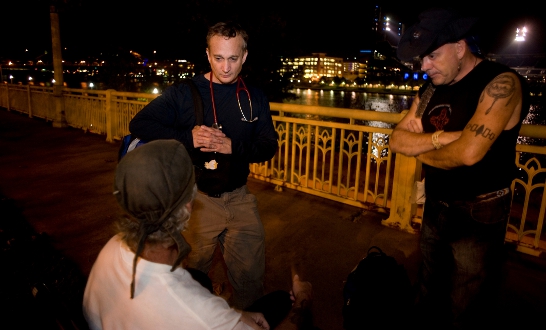Do Societal Systems Create a Public Health Problem of Homelessness?
Dennis is in his 50s. He’s spent 23 years in the state prison, where he lost one kidney, too many teeth, and a whole lot of faith in our justice system. Now he’s homeless. In his words, it’s “not as bad as prison, just different.”
This year, I am serving with the Pittsburgh Health Corps at Operation Safety Net, helping the eligible homeless apply for federal disability benefits. SSI and SSDI are federally-funded programs that provide monthly benefits to people with limited incomes who have a disability that keeps them from working at a substantial and gainful level. The point: having a small income (the maximum amount for SSI is $733 per month) helps folks obtain subsidized housing, pay co-pays for medical bills, and buy necessities, such as bus tickets and personal care products.
Homelessness is generally understood to arise from a few major risk factors: substance use; mental health issues; a lack of access to safe, affordable housing and employment; and cyclical encounters with the criminal justice system. Each of these determinants can precipitate a second round of debilitating factors: estrangement from friends and family, job loss, and “quality of life offenses,” such as stealing money to buy food. These often coalesce into a downward spiral for the individual.
While working with people who are homeless, I’ve found that the criminal justice system is the common thread that weaves mental health, substance use, and employment issues into a sticky web. Any amount of jail time makes homelessness increasingly likely. Incarcerated individuals, whether they are taken from society for weeks, months, or years, leave prison more debilitated than when they entered it. Often they lose the social capital of friends and family. Those eligible – and many are – lose necessary federal disability benefits. Convicted felons lose housing and employment options.
At weekly meetings, outreach workers and case managers from Operation Safety Net meet with other homeless providers such as Community Human Services, the Downtown Pittsburgh Partnership, the Department of Human Services, and the Pittsburgh Police Department in order address the causes of homelessness in Allegheny County. The variety of providers address the matrix of social institutions that collude to relegate a certain demographic – commonly substance users and those with mental health issues – to homelessness.
As long as homelessness is related to and exacerbated by untreated mental and physical illnesses, our community faces a serious public health problem. As a Pittsburgh Health Corps member, I see a huge opportunity here for change, and by understanding the issues and collaborating with outside organizations and government agencies, I am starting to make a difference in the Pittsburgh community to reduce homelessness and increase my clients’ adherence to mental and physical health care visits.

Operation Safety Net founder, Dr. Jim Withers, talks with a consumer on one of Pittsburgh's many bridges.